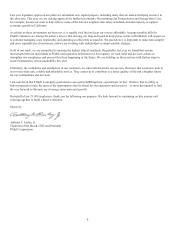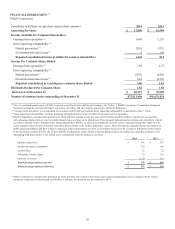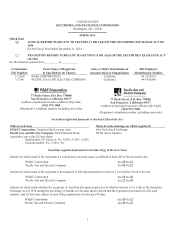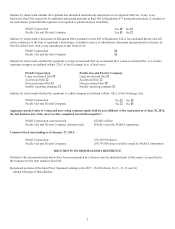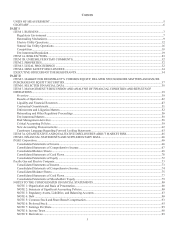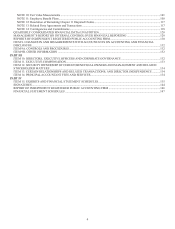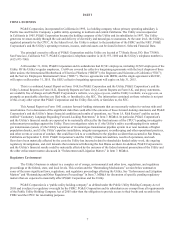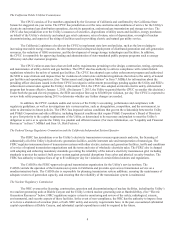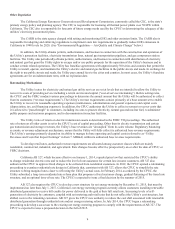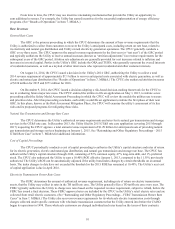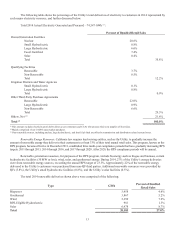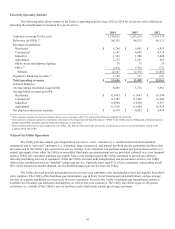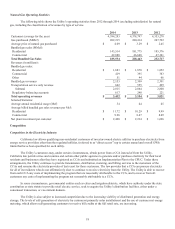PG&E 2014 Annual Report Download - page 16
Download and view the complete annual report
Please find page 16 of the 2014 PG&E annual report below. You can navigate through the pages in the report by either clicking on the pages listed below, or by using the keyword search tool below to find specific information within the annual report.8
The California Public Utilities Commission
The CPUC consists of five members appointed by the Governor of California and confirmed by the California State
Senate for staggered six-year terms. The CPUC has jurisdiction over the rates and terms and conditions of service for the Utility’s
electricity and natural gas distribution operations, electricity generation, and natural gas transmission and storage services. The
CPUC also has jurisdiction over the Utility’s issuances of securities, dispositions of utility assets and facilities, energy purchases
on behalf of the Utility’s electricity and natural gas retail customers, rates of return, rates of depreciation, oversight of nuclear
decommissioning, and aspects of the siting of facilities used in providing electric and natural gas utility service.
The California Legislature also directs the CPUC to implement state laws and policies, such as the laws relating to
increasing renewable energy resources, the development and widespread deployment of distributed generation and self-generation
resources, the reduction of GHG emissions, and the development of energy storage technologies and facilities. In addition,
the CPUC is responsible for approving funding and administration of state-mandated public purpose programs such as energy
efficiency and other customer programs.
The CPUC enforces state laws that set forth safety requirements pertaining to the design, construction, testing, operation,
and maintenance of utility electric and gas facilities. The CPUC also has authority to enforce compliance with certain federal
regulations related to the safety of natural gas facilities. The CPUC has adopted a gas safety enforcement program and authorized
the SED to issue citations and impose fines for violations of certain state and federal regulations that relate to the safety of natural
gas facilities and operating practices. (See “Enforcement and Litigation Matters” in Item 7. MD&A for information about the
presiding officer decisions issued in the three CPUC investigative enforcement proceedings pending against the Utility and SED’s
enforcement actions taken against the Utility.) In December 2014, the CPUC also adopted an interim electric safety enforcement
program that became effective January 1, 2015. (On January 7, 2015, the Utility requested that the CPUC reconsider this decision.)
Under both the gas and electric programs, the SED can impose fines up to $50,000 per violation, per day. The CPUC is expected to
review both safety programs during 2015 to determine whether any further changes are needed.
In addition, the CPUC conducts audits and reviews of the Utility’s accounting, performance and compliance with
regulatory guidelines, as well as investigations into various matters, such as deregulation, competition, and the environment, in
order to determine its future policies. The CPUC has imposed various conditions that govern the relationship between the Utility
and PG&E Corporation and other affiliates, including financial conditions that require PG&E Corporation’s Board of Directors
to give first priority to the capital requirements of the Utility, as determined to be necessary and prudent to meet the Utility’s
obligation to serve or to operate the Utility in a prudent and efficient manner. (For more information, see “Liquidity and Financial
Resources” in Item 7. MD&A and Item 1A. Risk Factors.)
The Federal Energy Regulatory Commission and the California Independent System Operator
The FERC has jurisdiction over the Utility’s electricity transmission revenue requirements and rates, the licensing of
substantially all of the Utility’s hydroelectric generation facilities, and the interstate sale and transportation of natural gas. The
FERC regulates interconnections of transmission systems with other electric systems and generation facilities, tariffs and conditions
of service of regional transmission organizations and the terms and rates of wholesale electricity sales. The FERC also is charged
with adopting and enforcing mandatory standards governing the reliability of the nation’s electricity transmission grid, including
standards to protect the nation’s bulk power system against potential disruptions from cyber and physical security breaches. The
FERC has authority to impose fines of up to $1 million per day for violation of certain federal statutes and regulations.
The CAISO is the FERC-approved regional transmission organization for the Utility’s service territory. The
CAISO controls the operation of the transmission system in California and provides open access transmission service on a
nondiscriminatory basis. The CAISO also is responsible for planning transmission system additions, ensuring the maintenance of
adequate reserves of generation capacity, and ensuring that the reliability of the transmission system is maintained.
The Nuclear Regulatory Commission
The NRC oversees the licensing, construction, operation and decommissioning of nuclear facilities, including the Utility’s
two nuclear generating units at Diablo Canyon and the Utility’s retired nuclear generating unit at Humboldt Bay. (See “Electric
Generation Resources” below.) NRC regulations require extensive monitoring and review of the safety, radiological, seismic,
environmental, and security aspects of these facilities. In the event of non-compliance, the NRC has the authority to impose fines
or to force a shutdown of a nuclear plant, or both. NRC safety and security requirements have, in the past, necessitated substantial
capital expenditures at Diablo Canyon, and substantial capital expenditures could be required in the future.


